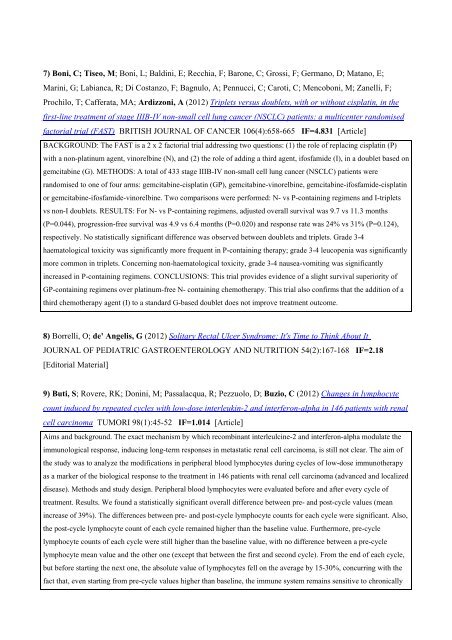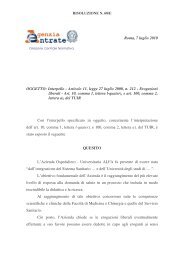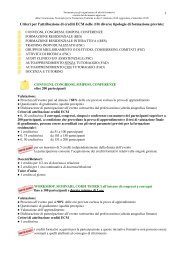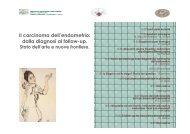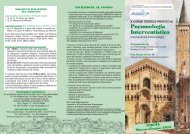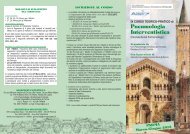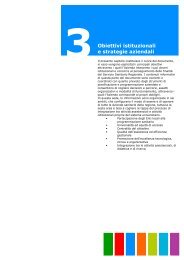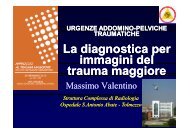COLLEGIO DI DIREZIONE - Azienda Ospedaliera di Parma
COLLEGIO DI DIREZIONE - Azienda Ospedaliera di Parma
COLLEGIO DI DIREZIONE - Azienda Ospedaliera di Parma
You also want an ePaper? Increase the reach of your titles
YUMPU automatically turns print PDFs into web optimized ePapers that Google loves.
7) Boni, C; Tiseo, M; Boni, L; Bal<strong>di</strong>ni, E; Recchia, F; Barone, C; Grossi, F; Germano, D; Matano, E;<br />
Marini, G; Labianca, R; Di Costanzo, F; Bagnulo, A; Pennucci, C; Caroti, C; Mencoboni, M; Zanelli, F;<br />
Prochilo, T; Cafferata, MA; Ar<strong>di</strong>zzoni, A (2012) Triplets versus doublets, with or without cisplatin, in the<br />
first-line treatment of stage IIIB-IV non-small cell lung cancer (NSCLC) patients: a multicenter randomised<br />
factorial trial (FAST) BRITISH JOURNAL OF CANCER 106(4):658-665 IF=4.831 [Article]<br />
BACKGROUND: The FAST is a 2 x 2 factorial trial addressing two questions: (1) the role of replacing cisplatin (P)<br />
with a non-platinum agent, vinorelbine (N), and (2) the role of ad<strong>di</strong>ng a third agent, ifosfamide (I), in a doublet based on<br />
gemcitabine (G). METHODS: A total of 433 stage IIIB-IV non-small cell lung cancer (NSCLC) patients were<br />
randomised to one of four arms: gemcitabine-cisplatin (GP), gemcitabine-vinorelbine, gemcitabine-ifosfamide-cisplatin<br />
or gemcitabine-ifosfamide-vinorelbine. Two comparisons were performed: N- vs P-containing regimens and I-triplets<br />
vs non-I doublets. RESULTS: For N- vs P-containing regimens, adjusted overall survival was 9.7 vs 11.3 months<br />
(P=0.044), progression-free survival was 4.9 vs 6.4 months (P=0.020) and response rate was 24% vs 31% (P=0.124),<br />
respectively. No statistically significant <strong>di</strong>fference was observed between doublets and triplets. Grade 3-4<br />
haematological toxicity was significantly more frequent in P-containing therapy; grade 3-4 leucopenia was significantly<br />
more common in triplets. Concerning non-haematological toxicity, grade 3-4 nausea-vomiting was significantly<br />
increased in P-containing regimens. CONCLUSIONS: This trial provides evidence of a slight survival superiority of<br />
GP-containing regimens over platinum-free N- containing chemotherapy. This trial also confirms that the ad<strong>di</strong>tion of a<br />
third chemotherapy agent (I) to a standard G-based doublet does not improve treatment outcome.<br />
8) Borrelli, O; de' Angelis, G (2012) Solitary Rectal Ulcer Syndrome: It's Time to Think About It<br />
JOURNAL OF PE<strong>DI</strong>ATRIC GASTROENTEROLOGY AND NUTRITION 54(2):167-168 IF=2.18<br />
[E<strong>di</strong>torial Material]<br />
9) Buti, S; Rovere, RK; Donini, M; Passalacqua, R; Pezzuolo, D; Buzio, C (2012) Changes in lymphocyte<br />
count induced by repeated cycles with low-dose interleukin-2 and interferon-alpha in 146 patients with renal<br />
cell carcinoma TUMORI 98(1):45-52 IF=1.014 [Article]<br />
Aims and background. The exact mechanism by which recombinant interleulcine-2 and interferon-alpha modulate the<br />
immunological response, inducing long-term responses in metastatic renal cell carcinoma, is still not clear. The aim of<br />
the study was to analyze the mo<strong>di</strong>fications in peripheral blood lymphocytes during cycles of low-dose immunotherapy<br />
as a marker of the biological response to the treatment in 146 patients with renal cell carcinoma (advanced and localized<br />
<strong>di</strong>sease). Methods and study design. Peripheral blood lymphocytes were evaluated before and after every cycle of<br />
treatment. Results. We found a statistically significant overall <strong>di</strong>fference between pre- and post-cycle values (mean<br />
increase of 39%). The <strong>di</strong>fferences between pre- and post-cycle lymphocyte counts for each cycle were significant. Also,<br />
the post-cycle lymphocyte count of each cycle remained higher than the baseline value. Furthermore, pre-cycle<br />
lymphocyte counts of each cycle were still higher than the baseline value, with no <strong>di</strong>fference between a pre-cycle<br />
lymphocyte mean value and the other one (except that between the first and second cycle). From the end of each cycle,<br />
but before starting the next one, the absolute value of lymphocytes fell on the average by 15-30%, concurring with the<br />
fact that, even starting from pre-cycle values higher than baseline, the immune system remains sensitive to chronically


